TASTE & RESPONSE TO FOOD IN THE MOUTH
1/93
There's no tags or description
Looks like no tags are added yet.
Name | Mastery | Learn | Test | Matching | Spaced |
|---|
No study sessions yet.
94 Terms
importance of hypotonic saliva
taste buds are able to detect salt at much lower thresholds
what are consequences of lacking the ability to taste food
failure to recognise food with a high enough caloric content could mean a slow death from malnutrition
failure to detect a poison could result in near-instant death
no pleasure/ enjoyment could lead to malnourishment
what senses are involved in the acceptance or rejection of food
taste
smell
what are functions of taste
aids selection of food
detects particular chemicals
provides the brain with information about:
stimulus intensity
duration
quality/ edibility of food
avoid unpleasant/ noxious substances
aids digestion by saliva production
what are the types of taste categories
sweet - energy rich
sour - typically taste of acids
salt - important for electrolyte balance
bitter - sensing of diverse natural toxins
umami - taste of amino acids e.g. in meat broth, MSG, glutamate and aspartate
Japanese for delicious
what factors affect our taste (6)
genetics
olfaction
previous experience
adaptation
diseases
saliva production
age - saliva production changes which impacts our taste
how does the mouth respond to food taken in
chewing »
reflex secretion of saliva for lubrication »
breakdown of food into smaller particles and mixing with saliva for taste »
binding of food particles together to form a bolus for swallowing
briefly outline mastication
chewing, biting or grinding of food
preparation of food for swallowing
an unconscious act - voluntary input
what is the cycle of mastication
bolus of food initiates reflex inhibition of the muscles of mastication, causing the lower jaw to drop
this initiates a stretch reflex of the jaw muscles that leads to rebound contraction
the jaw rises to cause closure of the teeth
bolus is compressed against the linings of the mouth
state the muscles of mastication
temporalis
masseter
lateral pterygoid
medial pterygoid
what is the function of the temporalis
elevates and retracts the mandible
pulls the jaw posteriorly
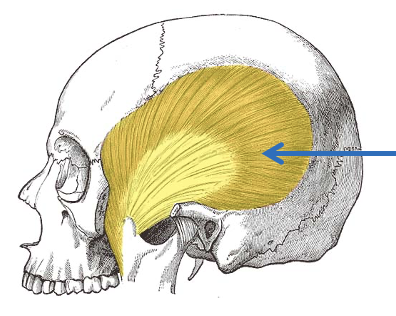
what is the function of the masseter
elevates the mandible
closes the mouth

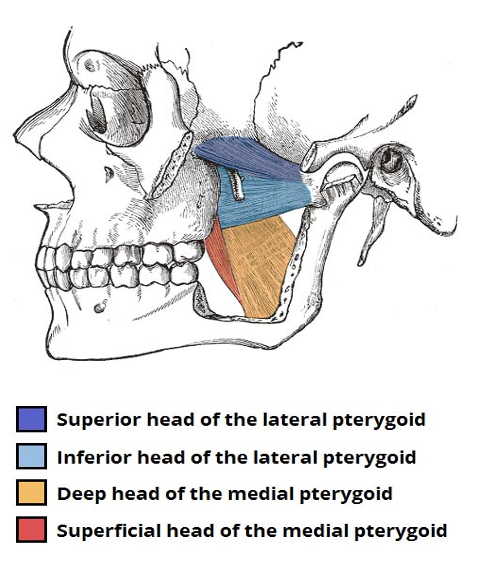
what is the function of the lateral pterygoid
has superior and inferior heads
unilateral contraction - contralateral excursion i.e. mandible moves to the opposite side
bilateral contraction - pulls the mandible forwards and downwards
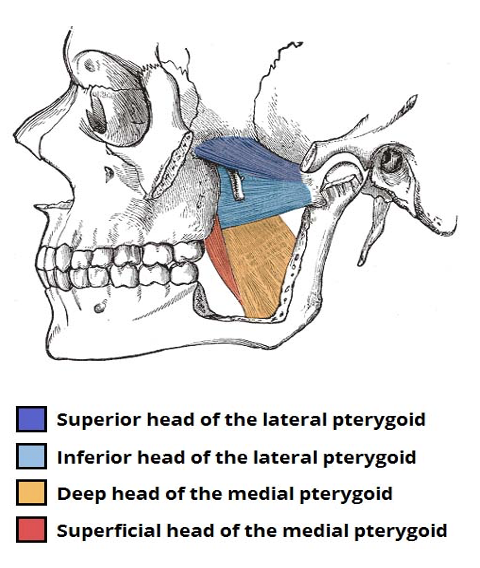
what is the function of the medial pterygoid
has deep and superficial heads
elevates the mandible and therefore closes the jaw
summarise the functions of the muscles of mastication
all move the mandible - all insert into the mandible
secures and stabilises position of the mandible
determines direction of movements
involved in biting and chewing
what is the motor innervation of the muscles of mastication
motor fibres of the mandibular branch of the trigeminal nerve (CN V3)
what structure allows us to taste
papillae (‘taste organs’)
what are papillae
raised protrusions on the tongue visible to the naked eye that contain the taste buds
where are papillae located
on the tongue, soft and hard palate, pharynx, epiglottis and larynx
what are taste buds
groups of 30-100 elongated ‘neuroepithelial’ cells
what are the types of taste buds
4 types of taste buds:
circumvallate
foliate
fungiform
filiform
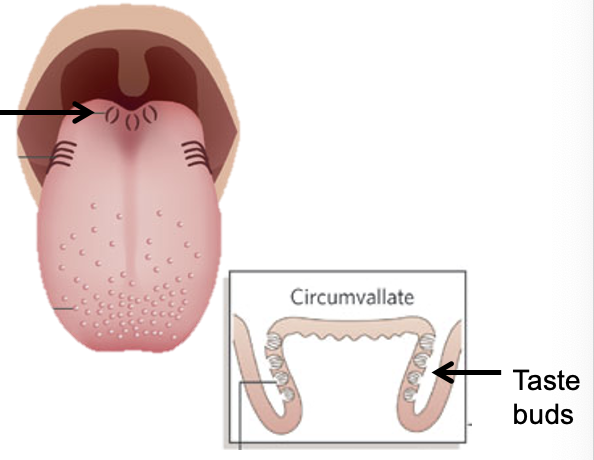
outline circumvallate taste buds
largest papillae
contain 100s of taste buds
located on posterior part of tongue forming a V shape
papillae are a sunken V shaped with troughs separating from surrounding wall - taste buds are located in tiers within the trough
3-13 in humans
which taste category do circumvallate papillae provide
sour/ bitter sensitivity to the posterior 2/3 of the tongue
which nerve innervates the circumvallate papillae
CN IX (glossopharyngeal)
provides taste and general sensation
histological section of circumvallate papillae
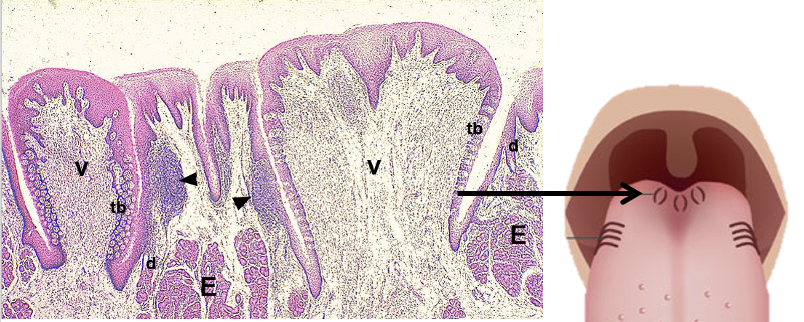

outline foliate taste buds
on the edge of the tongue, anterior to the circumvallate papillae
pockets are lined with taste buds
invaginations protect the taste buds
5.4 papillae per side of the tongue with 117 taste buds per papillae
which taste category do foliate papillae provide
sensitive to sour tastes - difficult to isolate
which nerves innervate foliate papillae
CN IX (glossopharyngeal)
chorda tympani - branch of CN VII (facial)
histological section of foliate papillae
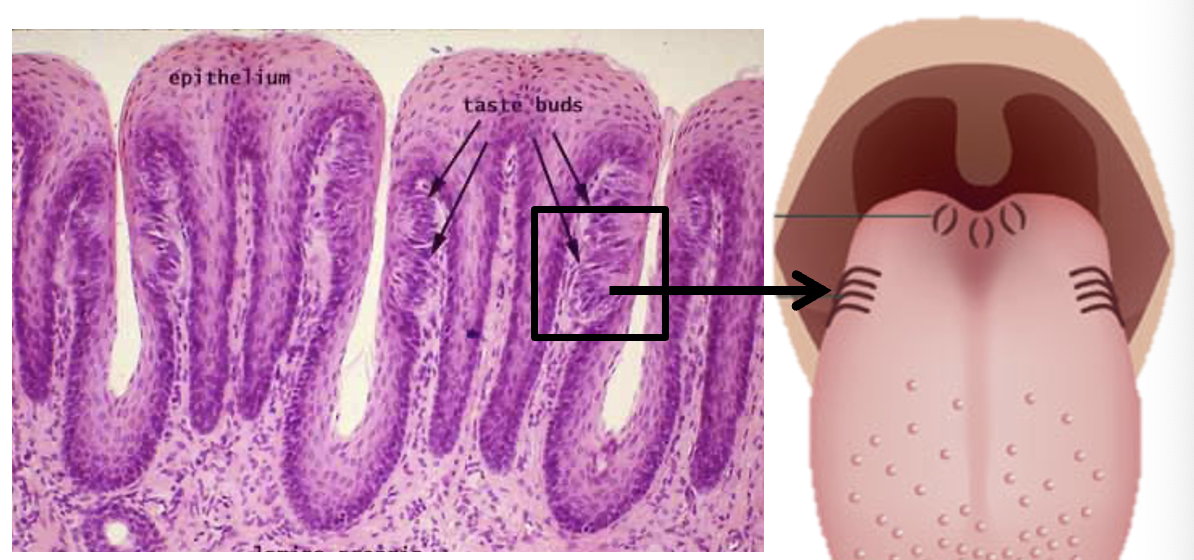
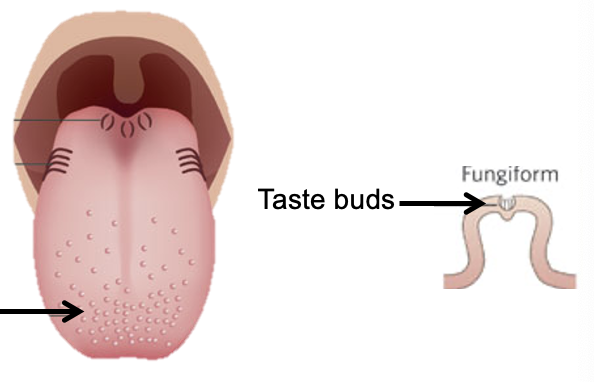
outline fungiform taste buds
located on anterior 2/3 of the tongue
mushroom shaped
appear as red spots due to rich blood supply
papillae at the front of the tongue have more taste buds (1-18) compared to the mid-region (1-9)
which nerve innervates fungiform papillae
chorda tympani - branch of CN VII (facial)
histological section of fungiform papillae
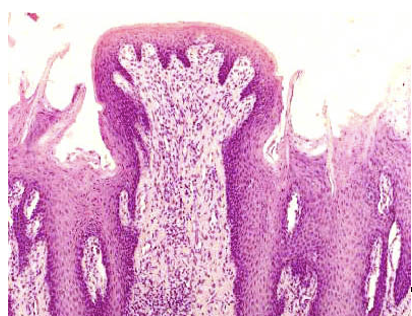

outline filiform taste buds
thin V shaped cones
thread-like
covers most of the anterior 2/3 of the tongue surface
NO TASTE BUDS
have a mechanical function instead - act like ‘velcro’ securing food to the tongue
histological section of filiform papillae
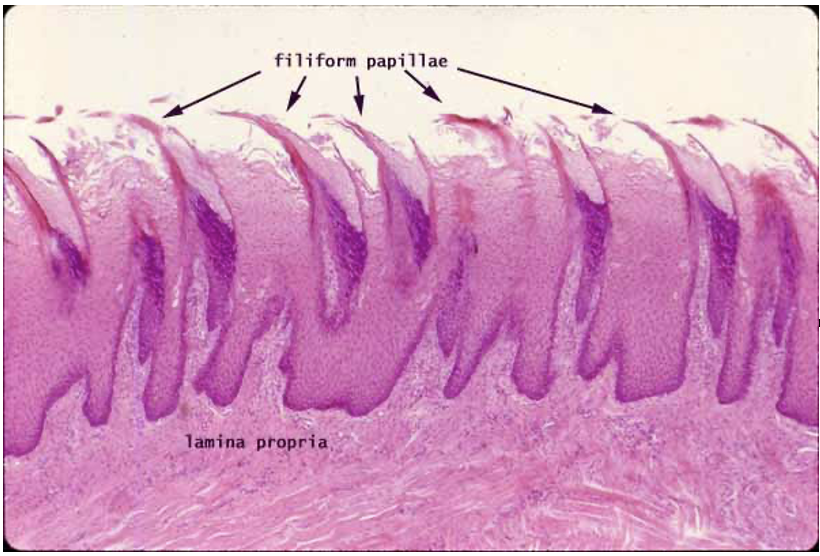
what are taste buds
functional units of (taste) papillae
how many taste buds does the tongue have
> 10,000 can occur singularly or in clusters
how many types of cells does each taste bud contain and what are they
each taste bud contains three kinds of cells:
epithelial cells
support cells
sensory receptor cells
outline epithelial cells
epithelial cells
basal
differentiate into new receptor cells
derived from surrounding epithelium
renewed every 10 days
outline support cells
support cells
contain microvilli
secrete substances into lumen of taste bud
outline sensory receptor cells
sensory receptor cells
peg-like extensions projecting into lumen
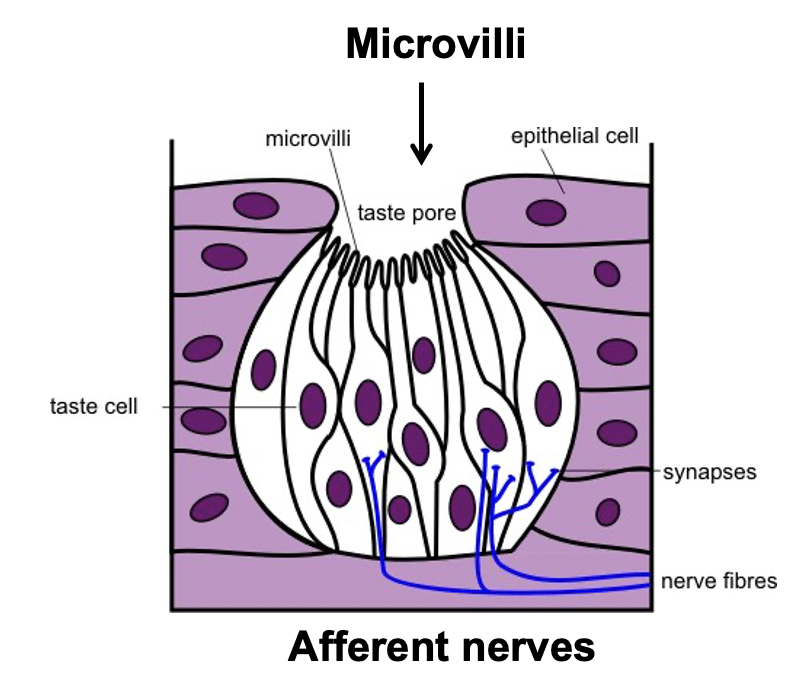
outline the structure of taste buds
onion shaped
contain 50-100 continuously maturing cells
apical microvilli increase surface area
receptor proteins exposed through taste pores
ion channels/ receptors located on villi
what is the function of the taste ‘bud’
bud shields the cells from the oral cavity
what are taste buds innervated by
gustatory afferent nerves
what is the life span of a taste bud
10 days
how is a taste bud formed
cells from the outside of the bud move inwards and develop into taste cells
what happens after a taste cell dies
it is shed into the oral cavity
washed away by saliva
nerve terminals move and innervate a new taste cell
how is taste sensitivity distributed across the tongue
sensitivity to all tastes is distributed across the whole tongue and soft palate/ epiglottis - there are differences in the intensity of sensation from different regions of the tongue
outline the innervation of the gustatory system
taste transduction
taste impulses from the anterior 2/3 of the tongue pass to the facial nerve
impulses from the posterior regions of the tongue and throat pass through CN IX (glossopharyngeal)
impulses from the base of the tongue pass through CN X (vagus)
—
these impulses travel to the gustatory nucleus in the medulla which then sends impulses to the thalamus and cortex
what information does CN V (trigeminal) convey
thermal sensation
tactile sensation
pain sensation
each taste ________ has a different ________ and a different ____________ mechanism
each taste modality has a different receptor and a different transduction mechanism
what are the 2 transduction mechanisms
ionotropic
metabotropic
what is the transduction mechanism dependent on
the receptor
which taste modality is the ionotropic mechanism associated with
salt
outline the ionotropic transduction mechanism
movement of Na ions through Na channels causes depolarisation
Ca then enters through the voltage sensitivity Ca channels
this causes neurotransmitter release and the firing of primary afferent nerve - synaptic transmission
which taste modalities are the metabotropic mechanism associated with
sweet
bitter
umami
outline the metabotropic transduction mechanism
sweet, bitter and umami converge on a common transduction channel - TRPM5 (via phospholipase C)
TRPM5 is a calcium activated, non-selective cation channel
depolarisation is induced following increases in intracellular Ca2+
this causes the channel to open, producing a depolarising generator potential which leads to an action potential
—
indirectly linked with ion channels on the plasma membrane of the cell through signal transduction mechanisms such as G protein-coupled receptors
what transient receptor channel does sweet taste stimuli (glucose) bind to
T1R2
T1R3
what transient receptor channel does umami taste stimuli bind to
T1R1
T1R3
what transient receptor channel does bitter taste stimuli bind to
T2R
what is the taste of sourness essentially the taste of
sour tasting is essentially tasting acid (H+)
what is the acid-sensing channel
PKD2L1 channel (Polycystic kidney disease 2-like 1 protein)
also known as
TRPP2 channel (Transient receptor potential polycystic 2)
what type of channel is PKD2L1
a non-selective cation channel
how does sour taste protect the oral cavity
sour tasting protects intra oral tissues from damage from acidic compounds
which taste modality is the strongest activator of saliva secretion
sourness - because saliva will buffer the protons/ H+
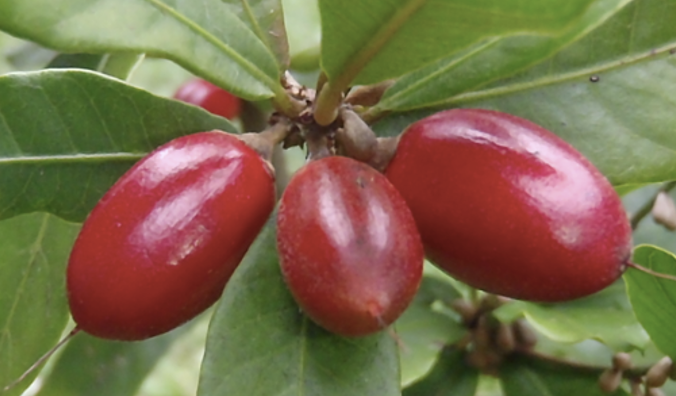
miracle berry or Synsepalum dulcificum - originally found in West Africa
what is the effect of ingesting miracle berry and what is it due to
miracle berries cause sour foods to taste sweet
this is due to a protein called miraculin
how does miraculin work at neutral and low pH
miraculin binds to taste buds causing sour foods to taste sweet
neutral pH: miraculin binds and blocks the receptors
low pH (sour foods): miraculin is able to activate the sweet receptors, resulting in the perception of sweet taste
how long does the effect of miraculin last
lasts until the protein is washed away by saliva i.e. 30 mins to 1h
what are the uses of miracle berry
sweeten palm wine
improve the flavour of sour cornbread - miracle berry is chewed first, then food is ingested
used as a sweetener and flavouring agent for lots of beverages and foods e.g. beer, cocktails, vinegar, pickles
process of tasting

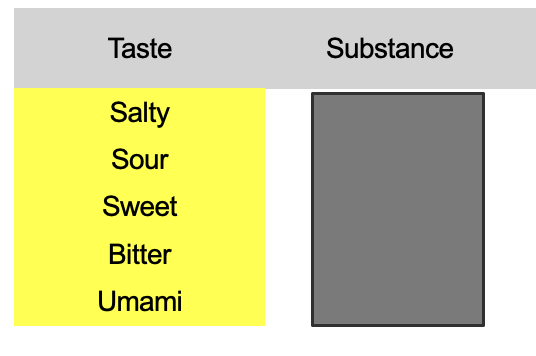
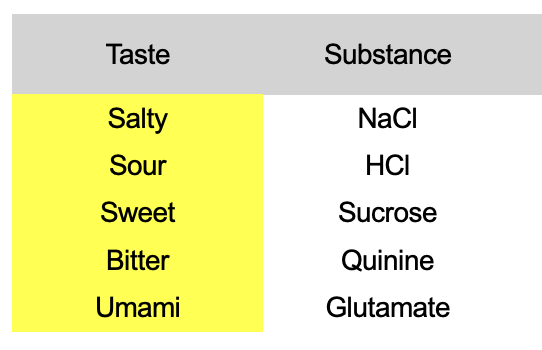
taste modality thresholds
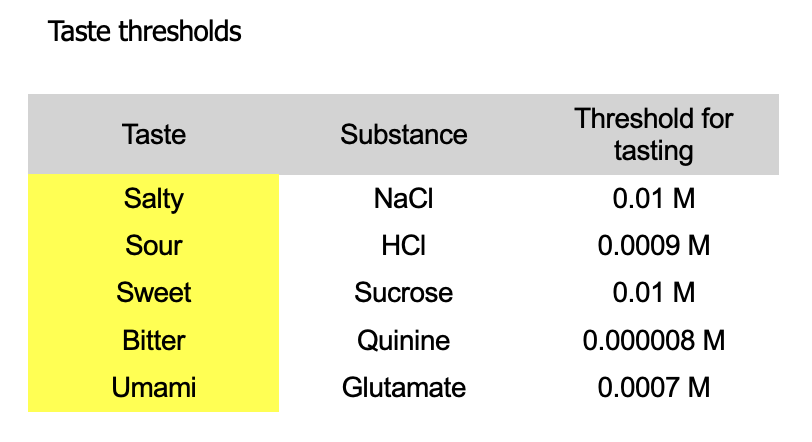
newborns tasting abilities
indifferent/ averse to salt
breast milk is sweet
at what age do babies start developing a preference for salty tastes
6-24 months
what is the range of taste cells per individual
500-10,000
who are supertasters
more papillae - particularly fungiform on their tongues than usual
they therefore have more taste receptors
% of population that are supertasters and number of papillae per cm
25% of the population - more women than men
165 papillae per cm
% of population that are normal tasters and number of papillae per cm
50% of population
127 papillae per cm
% of population that are non-tasters and number of papillae per cm
25% of population
117 papillae per cm
what substance is the major ingredient in tonic water
quinine - bitter taste
what does PTC stand for
phenylthiocarbamide
what does the ability to taste PTC determined by
genetics - genes encode taste receptor on tongue
what does PTC taste like to supertasters/ tasters VS non-tasters
bitter VS no taste
what is the frequency of non PTC tasters in
a) West Africa
b) China
c) India
d) Europe
a) West Africa: 3%
b) China: 6-23%
c) India: 40%
d) Europe: 30%
what kind of sensitivity does the tongue have to different taste modalities
regional sensitivity
where is sour taste usually perceived
at the sides of the tongue

where is bitter taste usually perceived
at the back of the tongue
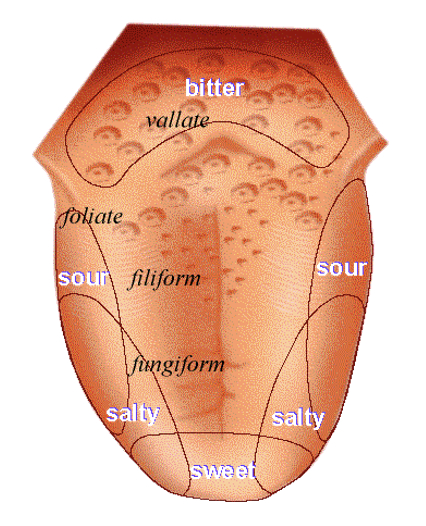
where are salt and sweet tastes usually perceived
at the front of the tongue
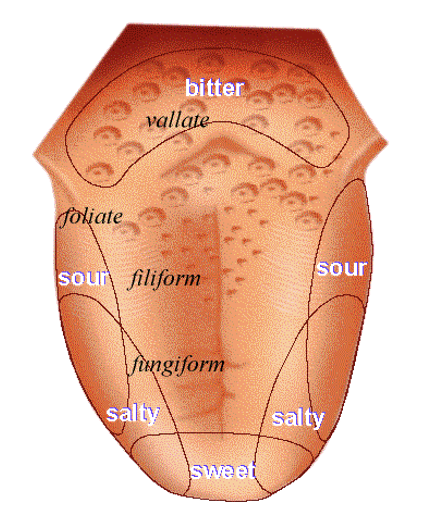
how many modalities is the olfactory system sensitive to
1000s
what does a disorder of olfaction e.g. cold lead to
altered gustation i.e. loss of taste
how does adaptation affect taste
repeated exposure to the same taste modality can induce a process of adaptation - decreased perceived intensity to the same concentration of a stimulus
how can adaptation to a taste be reset
by exposure to water
how saliva contributes to taste
taste stimuli are dissolved in saliva (solvent)
this allows them to reach and interact with taste receptors
—
ionic composition of saliva can affect the resting membrane potential of taste cells as the cells are bathed in saliva
this affects how sensitive taste cells are to taste stimuli i.e. taste perception
when are sweet, salt, sour and bitter compounds tasted
only when host threshold levels are exceeded